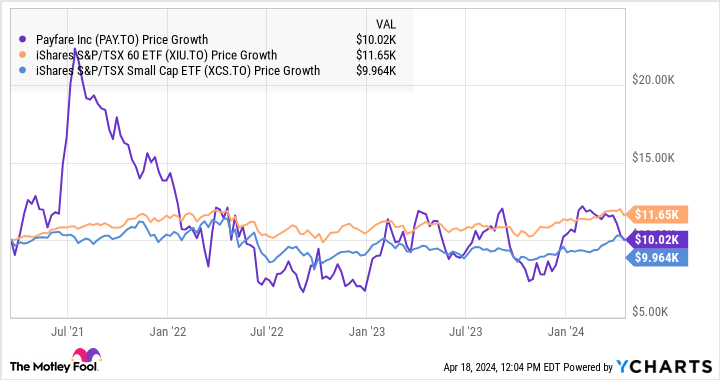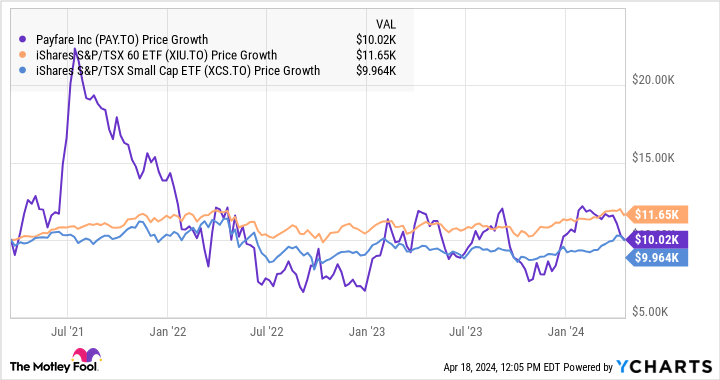Payfare Can Potentially Provide Explosive Growth

Written by Kay Ng at The Motley Fool Canada
You may or may not have heard of Payfare (TSX:PAY), which had its initial public offering in March 2021. Currently, it has a market cap of about $289 million. So, it’s considered to be a small-cap stock.
As explained on its website, Payfare is a global financial technology company that powers digital banking, instant payment, and loyalty reward solutions for the gig economy workforce, including independent contractors and freelance workers who offer goods or services to consumers and businesses.
It partners with leading platforms and marketplaces, such as Uber, Lyft and DoorDash. According to a survey done by Visa in 2019, 84% of workers want access to their earnings between pay periods. Payfare precisely fills this need by providing instant or near-instant access to gig worker earnings not yet received through traditional pay cycles. Earnings are automatically paid out to a free digital bank account powered by Payfare.
Payfare generates a decent portion of recurring revenue, making about 70-80% of its revenue from network interchange fees from payment networks and roughly 20-30% from user banking fees, including ATM withdrawals, money transfers, and foreign exchange.
The company postponed its annual filings, which it estimates to be completed by May 2, because of a delay in receiving an auditor’s report. Therefore, investors can currently only get earnings results for the business up till the third quarter (Q3) of 2023. The stock’s recent weakness of about 15% may have to do with this delay.
Payfare last reported active users of approximately 1.25 million, which was up about 32% year over year. Based on the numbers reported as of Q3, the little company is expected to turn a profit last year, with a return on equity of close to 20%, according to Morningstar. Furthermore, the company has a strong balance sheet — last reporting $56 million of cash and no debt on its balance sheet, which provides more financial flexibility to drive growth.
It has tremendous organic growth opportunities as the size of the gig economy transactions is projected to grow at a double-digit rate.
The volatility of small-cap stocks
One thing to highlight is that small-cap stocks could be more volatile than large-cap stocks. Since they are relatively small, any news — good or bad — would have a bigger impact on the stock immediately. Here’s a comparison of the value change of a $10,000 investment in the Canadian stock market (using iShares S&P/TSX 60 Index ETF as a proxy), small caps (using iShares S&P/TSX Small Cap Index ETF as a proxy), and Payfare based on stock price change only.
PAY data by YCharts
Adding the return from cash distributions, the Canadian stock market continued to outperform in the period. It currently offers a cash distribution yield of approximately 3%. It may be surprising that the small-cap exchange-traded fund (ETF) also offers cash distributions, which allowed it to outperform Payfare in terms of total returns in the period. Currently, the ETF provides a cash distribution yield of about 2.5%, which is not bad given that many small caps typically retain capital to reinvest into their businesses instead of paying out dividends.
PAY data by YCharts
Also, investors should take note that Payfare exploded upwards in its early days of trading. These are the kinds of moves that investors need to get used to if they’re investing in individual small-cap stocks. Payfare could provide relatively high growth for a diversified portfolio. Interested investors should investigate further.
The post Payfare Can Potentially Provide Explosive Growth appeared first on The Motley Fool Canada.
Should you invest $1,000 in Payfare Inc. right now?
Before you buy stock in Payfare Inc., consider this:
The Motley Fool Stock Advisor Canada analyst team just identified what they believe are the 10 best stocks for investors to buy now… and Payfare Inc. wasn’t one of them. The 10 stocks that made the cut could potentially produce monster returns in the coming years.
Consider MercadoLibre, which we first recommended on January 8, 2014 ... if you invested $1,000 in the “eBay of Latin America” at the time of our recommendation, you’d have $15,578.55!*
Stock Advisor Canada provides investors with an easy-to-follow blueprint for success, including guidance on building a portfolio, regular updates from analysts, and two new stock picks each month – one from Canada and one from the U.S. The Stock Advisor Canada service has outperformed the return of S&P/TSX Composite Index by 32 percentage points since 2013*.
See the 10 stocks * Returns as of 3/20/24
More reading
Can You Guess the 10 Most Popular Canadian Stocks? (If You Own Them, You Might Be Losing Out.)
How to Build a Bulletproof Monthly Passive-Income Portfolio in 2024 With Just $25,000
Fool contributor Kay Ng has positions in Visa. The Motley Fool has positions in and recommends Payfare. The Motley Fool recommends DoorDash, Uber Technologies, and Visa. The Motley Fool has a disclosure policy.
2024

 Yahoo Finance
Yahoo Finance 

